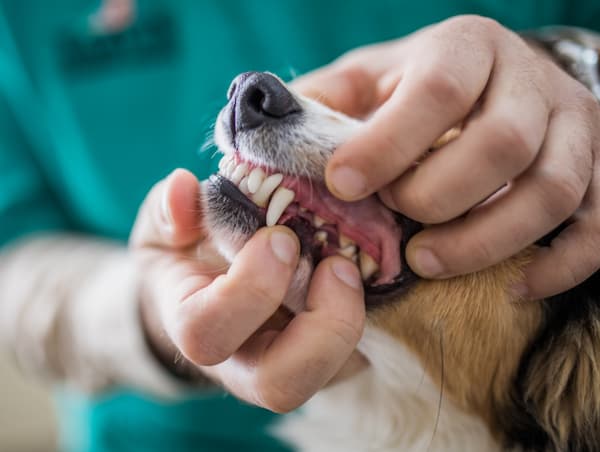What Does the Color of your dog's gums mean?

Examining the hue of the dog's gums could provide you with an indication of their overall health. Healthy gums for dogs are pinkish powder. If this color or other characteristics of normal gums change like moistness or temperature could indicate that something is not right and must be investigated further by a vet.
The color of the dog's gums that is sick can be blue, black, or white. Or it could be bright red. Gums that don't look pink could indicate problems that range from gum illness to heart failure due to congestion. Find out what the different colors of dog gums mean and other gum problems that are unhealthy to be aware of.
What are normal dogs' gums? look like?
Normal gums should have pink in color. If you press them by your index finger the gums should change color to light or white-pink hue and then rapidly (within 2 seconds) back to their normal pink hue when you remove your finger and off the gums.
The time it takes the gums to return to their normal pink color once you have pressed them on them is known as the capillary refill time or CRT. Gums should also be pliable or moist and smooth in the event that you ran your fingers over them. They shouldn't be dry or sticky.
Gum Probleme in dogs:
- Blue Gums: In the event that there is a lack of oxygen circulating through the blood supply of your dog and the gums become blue or purple.1 The color of the gum is known medically as cyanosis. Cyanosis can result from various conditions.Congestive heart failure, pneumonia, pulmonary thromboembolism, and other respiratory issues can trigger the blue coloration of gums when the condition is serious due to a drop in the oxygenated flow of blood. All of these are very dangerous.
- Pale Pink or White Gums: In the event of a deficiency of hemoglobin or blood evident in the dog the gums could be light pink, or may even be white. It is usually an indication of anemia or sudden blood loss.2 A variety of underlying illnesses can lead to anemia and even trauma could cause massive, sudden blood loss. Since the body isn't able to produce enough blood flow the normal color of pink of the skin fades. Anemia is a condition that can be extremely grave.
- Bright red gums: If your dog's teeth are bright or red, pink, then it might indicate that they are hot or suffer from stomatitis or gingivitis. Dogs suffering from heatstroke frequently have bright red gums because they pant in an effort to lower their body temperature.3 Red gums that are bright are also a sign there is inflammation of the gums, or that they have an infection. These two issues may cause gums to appear to bleed more easily and may be painful.
- Growths on Gums: Oral tumors can be often seen in the dog's gums. Sometimes these tumors are not harmful or go away on their own, while at other times, they can be infected or cancerous. Papillomatosis is a virulent disease that easily spreads between dogs and causes pink, fleshy warts on the gums and other places on the body.4 These warts are usually not as alarming as other forms of tumors or growths. Some tumors may be cancerous, may cause serious health problems for dogs, and can cause problems with eating and discomfort.
- Bleeding gums: due to Stomatitis, gingivitis, and other growths may cause dogs' gums to become extremely sensitive and susceptible to bleeding.5 If your dog's got bleeding gums, it is recommended that he be examined by a veterinarian in order to identify the root cause.
The prevention of Gum Problems in Dogs
Based on the root cause of gum disease it could or might be completely avoidable.
- Blue Gums: These are conditions that prevent oxygen and breathing will result in blue gums, but these conditions are usually unavoidable. Make sure you don't smoke in the vicinity of your dog and seek veterinary attention immediately should your dog be experiencing difficulty breathing due to reasons of any kind.
- Pale pink or white Gums: An acute loss of blood and other diseases that cause anemia need to be treated immediately to stop pale or white gums from forming.
- Bright red gums: Keeping your pet at regular body temperature can prevent the bright red gums noticed in dogs who are too hot. However, if the gums appear red due to gingivitis or stomatitis and regular dental treatment must be taken to prevent the condition from recurring.
- Growths on Gums: The development of warts could be reduced by restricting exposure to dogs who are suffering from these warts. If the growths are cancerous, or other types of mass, there isn't any method to prevent their development.
- Gums bleeding: If the gums are bleeding because of bad dental hygiene, consistently brushing your teeth and giving proper dental treatment is essential to maintain healthy gums.
Treatment of Gum Issues in Dogs
The treatment options differ for gum issues in dogs. If you have gum problems that are caused by respiratory disorders and require immediate oxygen therapy, it is frequently required along with medications that are specific to the disease.
For white or pale pink gums, a dog might require a blood transfusion because of anemia or loss of blood. If there is growth it is possible to have surgery to remove it from the gums. Cleaning and extraction of teeth, medication as well as laser treatment for cold therapy could be required to treat gum bleeding or bright red gums. If your dog is hot and has bright red gums cooling it down will help with the issue.

Comments
Post a Comment